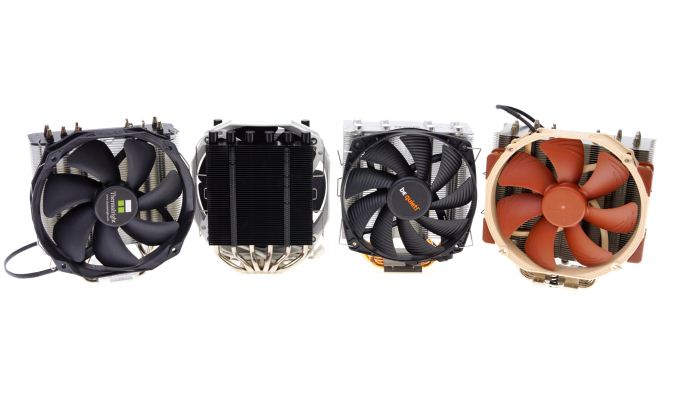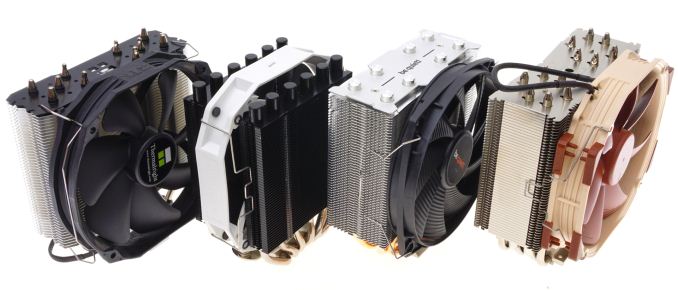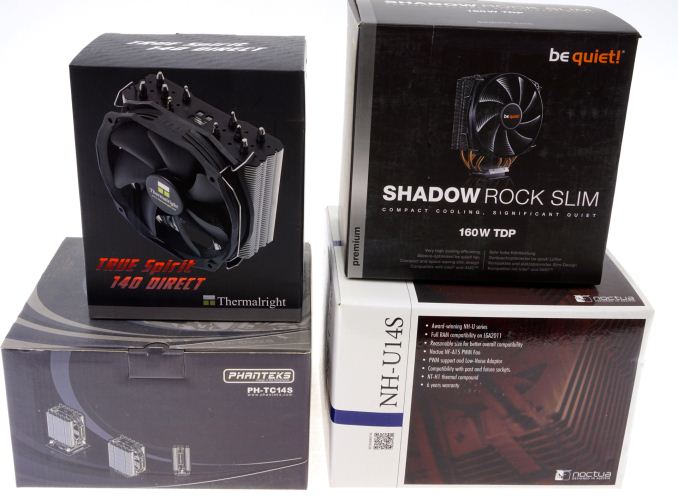The 140mm Slim Tower CPU Cooler Roundup: Thin & Light Done Just Right
by E. Fylladitakis on May 24, 2017 8:00 AM EST- Posted in
- Cases/Cooling/PSUs
- be quiet!
- Noctua
- Phanteks
- Cooler
- Thermalright

A standard cooler is supplied with nearly all retail boxed CPUs, which guarantees adequate cooling performance under normal operating conditions. Enthusiasts however are rarely satisfied with the performance of stock CPU coolers, seeking either better overall performance or lower noise levels. This is especially true for those who are planning to overclock their systems, as the supplied coolers usually don't have the extra performance required for handling overdriven processors.
However, the selection of a CPU cooler is a complicated matter. It depends on the available space, the user’s needs and wants, as well as on the available budget. For example, some users might require high performance but low profile coolers due to limited space, while others may have spacious cases and high enough budgets to afford a huge dual-tower cooler.
In today's review we will be having a look at some of the most popular single tower 140 mm CPU coolers currently available. Considering that height usually is the primary concern with CPU coolers, single tower 140 mm coolers virtually have the same space requirements as the dual tower 140 mm coolers do. Their distinct advantages however are much lower weight and significantly more competitive pricing. This makes them ideal for users that do have the available space, but do not require the performance of a dual-tower behemoth or move their system often, in which case the cooler’s weight becomes a major safety concern.
 Thermalright True 140 Direct, Phanteks PH-TC14S, Be Quiet! Shadow Rock Slim, & Noctua NH-U14S
Thermalright True 140 Direct, Phanteks PH-TC14S, Be Quiet! Shadow Rock Slim, & Noctua NH-U14S
The four coolers that we are taking a look at in this roundup review are the: Noctua NH-U14S, Phanteks PH-TC14S, Thermalright True Spirit 140 Direct, and the Be Quiet! Shadow Rock Slim. All four of these coolers have similar space requirements and pricing, but they are certainly not created equal. We will have a closer look at their individual strengths and weaknesses in the following pages of this review.
| 140mm Tower CPU Coolers | ||||
| Product | Fan(s) | Fan Speed (RPM) | Height (mm/in) | Current Retail Pricing |
| Noctua NH-U14S | 1 × 140 mm | 1500 RPM | 165 mm / 6.5” | $65 |
| Phanteks PH-TC14S | 1 × 140 mm | 1300 RPM | 160 mm / 6.3” | $50 |
| ThermalRight True Spirit 140 Direct | 1 × 140 mm | 1600 RPM | 161 mm / 6.34” | $47 |
| Be Quiet! Shadow Rock Slim | 1 × 140 mm | 1400 RPM | 161 mm / 6.34” | $50 |











74 Comments
View All Comments
Samus - Wednesday, May 24, 2017 - link
I think the thermalright cooler is pretty hard to ignore unless you are running a high-wattage CPU. Mild overclocks of a typical 80w CPU will make the thermalright the ideal solution at ~100w load, and also the quietest.Communism - Wednesday, May 24, 2017 - link
The problem with E. Fylladitakis 's style of testing is that they miss major factors in how the things tested actually function in relation to what they are made for.The reason why Noctua always does "better" in these synthetic tests is that they generally have a 100% flat contact surface.
The problem with 100% flat contact surfaces is that CPU IHS aren't anywhere close to 100% flat surfaces.
Most CPU IHS are concave, which is why Thermalright HSF always have convex contact surfaces.
Clamping pressure is also highly important, especially for Intel's non-soldered IHS CPUs.
Higher Clamping pressure both reduces the distance between the silicon and the IHS as well as forms a better mating between the IHS and the convex Thermalright contact surfaces.
These, and many other major factors that crop up in the real world make the 100% artificial testing like E. Fylladitakis conducts in actually have an extremely large margin of error, making them far less useful than the testing "scienciness" would lead you to believe.
fanofanand - Thursday, May 25, 2017 - link
If what you are suggesting is true, we should see Thermalright outperforming Noctua in every other publication's testing, correct? Most review sites (I believe all other sites actually) test CPU cooler performance on an actual CPU running tests, and more often than not inside of an actual computer case. Yet those same tests bring very similar results to what Anandtech has shown, which would appear to invalidate your entire postulation. How do you explain the lack of disparity between these other journalists' "real world" cases, and what Anandtech has done?Communism - Thursday, May 25, 2017 - link
Keep up your rhetorical questions.I don't know why I bother posting on this shill infested site anyways, waste of my time.
I'm not going to spoon-feed you for 20 posts like the forums.
I've spoonfed you for literally 100 posts before on the forums and your shill self has never acknowledged anything, making this a pointless conversation by any metric.
Have fun shilling with the other shills, adequate journalism in technology died quite a long time ago, and it shows.
Zetbo - Friday, May 26, 2017 - link
What a loser you are. When the data does not backup your point of view...you call everyone a shill! Thats the way to go! :DCommunism - Friday, May 26, 2017 - link
Took you a whole day to make another account?You really should get your pay docked.
Keep going and you're getting doxed.
fanofanand - Friday, May 26, 2017 - link
Doxx me big boy :)fanofanand - Friday, May 26, 2017 - link
Uh, I'm not on the forums, have you been taking mushrooms? I did read that they are the "least dangerous" psychadelics, but you seem to have overindulged. Apparently my point was irrefutable as you chose not to refute anything I wrote.BrokenCrayons - Friday, May 26, 2017 - link
The testing methods used in these HSF reviews are perfectly adequate because they remove a number of uncontrollable variables that would result from testing with PC hardware. The simulator equipment can produce repetable results with little to no variance between tests within AT's limited budget. I much prefer artifical tests as the basis for relative comparisons since the tests performed by other review sites won't accurately emulate my specific computing environment anyway and are therefore only useful as similarly relative comparisons. The science of these results appear trustworthy.WinterCharm - Thursday, May 25, 2017 - link
Funny how Thermalright performed better than Noctua at low and high fan speeds, then!